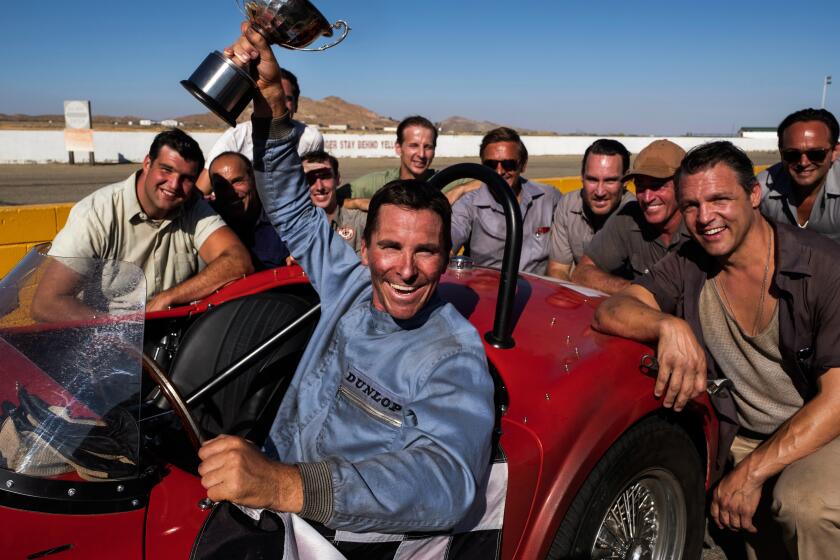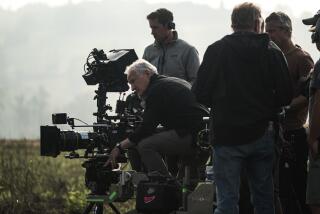In ‘Ford v Ferrari’, famed Le Mans racetrack came to life in Agua Dulce
- Share via
When director James Mangold set out to make the historical race drama “Ford v Ferrari,” he faced multiple hurdles in finding locations. The recently-released 20th Century Fox movie, likely to be inspected by legions of obsessive race fans, had to be accurate down to the smallest detail.
But none of the cars that competed during the period are still manufactured and many of the tracks where they raced are gone, and nothing in the race world looks the way it did 50 years ago.
To build reality into their “based on a true story” movie — which stars Matt Damon and Christian Bale as, respectively, American race-car builder Carroll Shelby and English race-car driver Ken Miles — Mangold turned to production designer François Audouy (“Wolverine,” “Logan,” “Ghostbusters 2020”) and vehicle director Rob Johnson (“Avatar,” “Tron: Legacy,” “Avengers Endgame”).
One of the biggest puzzles included finding a way to film at the legendary Le Mans racetrack in France — proportionally too expensive for the film’s reported nearly $100-million budget. Mangold has said that cutting one race sequence that would have been shot there saved the filmmakers $7 million.
But the famed French track, where Ford challenged Ferrari for the 1966 world racing crown, couldn’t be eliminated entirely. Neither could races that took place at California’s Riverside International Raceway (now a shopping mall) or Florida’s Daytona International Speedway (still operational, but looking nothing like it did in the ’60s).
“There’s not much to use,” Johnson said. “How many speedways are available in Southern California for production? Uh, zero.”
The film, which opened in first place this weekend with $31 million in ticket sales, shot a number of scenes in Southern California with the help of a nearly $17 million film tax credit. For the races at Daytona, Mangold was able to use Auto Club Speedway in Fontana, about 50 miles east of Los Angeles. Other race scenes, including a final sequence showing Miles driving at Riverside, post-Le Mans, were filmed at a Honda test track deep in the Mojave Valley.
In still other scenes, the track at the Porsche Experience in Carson stood in for a Ford test track in Michigan. (For that one, Audouy said, some CGI work was needed to eliminate a little thing called the 405 Freeway from the background.)
For all of those race scenes, Audouy said, it was essential to tinker with sound as well as sight. Most of the vintage race cars in the movie are powered by stronger, more dependable modern engines. Sound designers had to re-create the exhaust sounds of 1960s race cars to replace the noise produced by 2018 Chevy V-8s.
Re-creating the race scenes at Le Mans required even more creativity. Mangold insisted they be correct in every detail, because they had to be. The track has hosted so many televised races that fans would smell a fake immediately.
Three tracks in Georgia provided answers. One, near Savannah, featured the greenery and vegetation, and the proper humidity, to match the look of the French countryside that surrounds Le Mans. The filmmakers constructed a fake house to match the one that sits along a specific stretch of the French track, to further enhance the verisimilitude.
When director James Mangold’s new movie “Ford v Ferrari” hits theaters Nov. 15, car nuts may find themselves asking where the filmmakers found all those classic Carroll Shelby race cars from the 1960s, which sell for millions of dollars when they become available.
A night driving sequence along a forested road in the rain was shot at a different track, near Statesboro. The weather was so cooperative, Johnson said, that the rain didn’t have to be manufactured. The rain sequences were shot in real rain, during a real downpour, and only at night — an exact match for what happened during the actual 1966 race.
A third Georgia track was used for a horrifying sequence in which a Ferrari crashes next to a Le Mans bridge that featured a huge Dunlop tire logo.
With the tracks shot, Mangold and his crew were left to figure out what to do with the surrounding Le Mans locations — grandstands, pits, garages and other key areas around the tracks, most of which have been replaced by more modern facilities.
Audouy said the decision was made to build what they couldn’t find. The result: A 400-foot structure, with interior and exterior aspects, constructed on a runway at Agua Dulce Airpark in the Santa Clarita Valley.
That facility was used to represent the grandstands and the pits at Le Mans, populated with period detail, period automobiles, period tools and actors, of course, wearing period racing gear. Audouy said Mangold was so intent on getting it right that he had 3-D models of the Agua Dulce set built before construction.
Some of the non-racing locations proved equally difficult to find. Shelby did a lot of his development at a hangar inside LAX. But no such hangar is available any more. The film’s location manager, Robert Foulkes, found an empty National Guard hangar at Ontario International Airport. By coincidence, there was even a vintage 727 parked nearby.
“We rented that and put it in period livery,” Johnson said, for use as a plane Henry Ford II uses for a surprise visit to Shelby’s garage.
A Southern California Edison building in Eagle Rock stood in for the Ferrari factory in Mandello, Italy, allowing the filmmakers to shoot the factory floor and the race workshop where Ferrari mechanics fine-tune the cars and their engines.
That was where Mangold shot the most expensive scenes in the movie, Audouy said. “We built three 330P3s and three F1 race cars, from scratch, but there were also several real Ferraris in those shots, valued from $6 million to $30 million each.”
But the exterior gates of the factory, and the entrance to Enzo Ferrari’s office? Not Eagle Rock, but Pomona College.
For the Ford factory, some office scenes were shot inside the former Los Angeles Times building in downtown L.A. Others, including an impressive scene in which Henry Ford II shuts down an assembly line to lecture his workers, were shot in an empty warehouse nearby. (That scene required the filmmakers to acquire 21 vintage Ford Falcons, which they could then disassemble to stand in for new vehicles, in various stages of construction, rolling through the assembly process.)
Perhaps the most complicated physical location was the neighborhood garage where racer Miles tries to make a living between races, fixing other people’s cars. Mangold insisted that the garage be physically right across the street from the little bungalow where Miles lives with his wife and son — so that, literally, Miles can see his house from the shop, and his wife can see him working from her front porch.
Remarkably, Audouy said, location scouts were able to find exactly that setup, in Highland Park. They evicted a small garage owner from his shop, and persuaded three roommates to move out of their house across the street. They rebuilt both buildings to period specifications, then borrowed and dressed up a little supermarket at the end of the block, and shot there for more than two months.
“We turned the entire area into a 1960s time machine,” Audouy said.
Even though so much of the film’s story takes place overseas, only one set of scenes was shot outside the U.S. An extended sequence in which Miles arrives in the village of Le Mans and strolls around the cobblestone street was shot in the actual village.
This came with an unexpected bonus. The nearby Le Mans museum — which through February of next year will host a special “Le Mans 66” exhibit tied to the movie — had a vintage Ford GT40 race car in its permanent collection.
“The museum people got wind of what we were doing, and they loaned us their GT40!” Johnson said. “They just said, ‘Would you like to use it?’ So we stuck it in the scene.”
Although the key action of the movie takes place on and around the racetrack at Le Mans, for Audouy the spirit of the movie is entirely local. The action in “Ford V Ferrari” begins at a racetrack in the Antelope Valley and ends at a racetrack in the Inland Empire.
“The whole thing is bookended with this American West background, where you can really feel the desert and mountains,” Audouy said. “In the end, it’s a real California story.”
More to Read
Inside the business of entertainment
The Wide Shot brings you news, analysis and insights on everything from streaming wars to production — and what it all means for the future.
You may occasionally receive promotional content from the Los Angeles Times.












